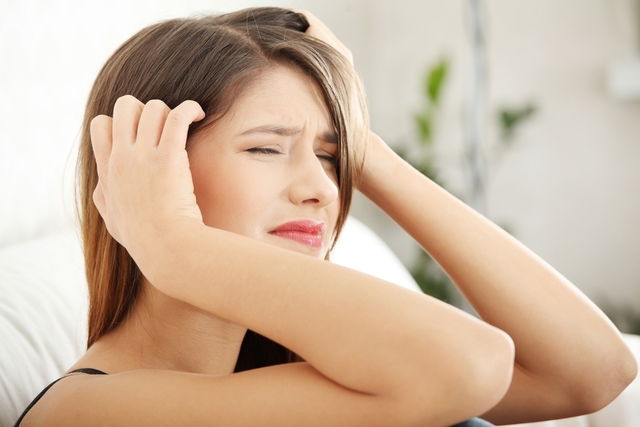Scalp pain can be triggered by many factors that contribute to sensitivity, like infections, infestations, skin issues or hair loss. These conditions can lead to inflammation and skin irritation, causing pain or discomfort.
Using very tight hairstyles (like brains or high-top buns), using a helmet for prolonged periods or using harsh shampoos can also cause pain and discomfort at the top of the head.
Treatment for scalp pain is usually simple, but depends on the underlying cause. Therefore, yu should see a dermatologist for assessment of scalp pain so that the mist appropriate treatment is initiated.

1. Dermatitis
Dermatitis is a skin inflammation that causes symptoms like redness, itchiness, and flaking. Dermatitis on the scalp can also lead to dandruff and blisters, leading to scalp pain or discomfort.
This condition can occur at any age and usually emerges after direct contact with common substances like metal, soaps, cosmetics, cosmetic procedures, pollution or even water.
What to do: Treatment depends on the type of dermatitis and what triggered it. Seborrheic dermatitis, for example, is typically treated with medicated shampoos that contain ketoconazole, salicylic acid, zinc pyrithione. Severe cases will require moisturizing lotions or topical corticosteroids.
2. Infections
Some scalp infections, like folliculitis or boils, can affect hair follicles and cause scalp sensitivity, making it more painful, sensitive and hot to the touch. Infections are more common in people with a history of diabetes, skin conditions (like eczema), or a weakened immune system.
A boil is usually caused by a build-up of Staphylococcus aureus bacteria. Folliculitis usually occurs due to ingrown hairs, but it can also happen with a bacterial or fungal infection. In serious cases of folliculitis, some people may even note significant hair loss.
What to do: Normally, antifungal shampoos like ketoconazole or topical antibiotics like erythromycin or clindamycin can resolve a scalp infection. However, some cases are more difficult to treat and require months-long treatment. You should avoid puncturing or squeezing boils or cysts, as it increases the risk for the infection to spread to other parts of the body. See other ways to you can treat a boil and speed-up healing.
3. Lice
Lice infestations are very contagious and usually affect school-aged children. Lice feed off of blood and survive for about 30 days, however they multiply very quickly. A female louse can lay 7 to 10 lice eggs per day. Lice infestations are associated with symptoms like intense scalp itching that can become painful and cause small wounds throughout the head.
What to do: Treatment for lice consists of medicated shampoo or lotion that contains pyrithione to kill the lice. You should then pass a fine-toothed comb through the hair to remove them. An additional repellant product should be used during treatment to prevent a recurrent infestation. Learn more about natural home remedies for lice that you can use to complement your prescribed treatment.
4. Headache
In some cases, a headache can cause scalp pain or increased scalp sensitivity. Stress, depression and anxiety and cause pain or worsen symptoms, which can contribute to muscular tension. See what else can cause a constant headache and what you can do to relieve it.
What to do: To relieve headaches, you can lightly massage the scalp, take a warm and relaxing bath, or take analgesics and anti-inflammatories, like acetaminophen or ibuprofen, as directed by your doctor.
5. Temporal arteritis
Temporal arteritis is a chronic inflammation of the arteries found on the sides of the head, close to the ears. It is associated with symptoms like headaches, fever, anemia, fatigue, general malaise and throbbing scalp pain.
This type of pain is more common in older adults, and can lead to severe systemic and eye complications.
What to do: Treatment for this condition should be monitored by a doctor, ans is usually aimed at relieving symptoms and preventing vision loss. Doctors will often prescribe corticosteroids, like prednisone, as well as analgesics and antipyretics, like acetaminophen, to manage fevers, fatigue and general malaise.
6. Hair loss
Areas of the scalp where hair loss is more significant can generally feel more sensitive or painful.
What to do: To prevent hair loss, you should maintain a balanced diet that is rich in protein, vitamins and zinc. There are supplements that contain most of your daily requirements, as well as those used specifically for hair loss prevention.
There are shampoos and topical lotions (such as those that contain minoxidil 5%) can help with stimulating hair growth and preventing further hair loss. Very severe cases can be treated with medications like finasteride or propecia. Check-out how you can also use biotin for hair growth if you are experiencing hair loss.
7. Ringworm
Ringworm of the scalp, also known as tinea capitis, is a fungal infection caused by Trichophyton and Microsporum fungi. It causes hair to break and fall out, and leads to the appearance of bald patches as well as sensitivity in the affected regions.
What to do: You should consult a dermatologist to initiate treatment with antifungal ointments or pills, like itraconazole or fluconazole. Treatment is aimed at eliminating the fungus to relieve symptoms. Read more about how ringworm is treated and what can cause it.
8. Shingles
Shingles, or herpes zoster, is an infectious illness that is caused by the same virus that triggers chicken pox. This virus can reemerge in adulthood and attacks the cranial nerves. It is associated with scalp pain, red blisters on the skin, skin burning, headaches and dizziness. Learn more about the symptoms of shingles and what causes it.
What to do: Shingles is usually treated with antiviral medication like acyclovir, gancyclovir or valacyclovir, as prescribed by a doctor or dermatologist. These medications decrease virus multiplication, which help to reduce the spread of blisters as well as the duration and severity of the illness.
